Injury and joint inflammation and prevention!

Chadwick891
Posts: 72 Member
I feel that this is a very important topic to readdress for everyone when and where possible.
This is a copy of what I composed in my Blog a few months ago.
Injury prevention
Injury prevention is very important. This area will discuss what you should be familiar with to help minimize the risk of injury and hopefully help you with any existing injuries you may have.
Stretching
The big word no one seems to be familiar with. STRETCHING. Stretching the muscle fibres is one of the most important things to do before any exercise. This includes, walking, HIIT, strength training etc.
You want to stretch the fascia of the muscle to allow proper blood flow into the muscle group. It also helps warm up the muscle fibre before taking big sets. I recommend stretching before the workout, in between sets and after the workout. This will not only prevent injury, but stretching the fascia also gives the muscle a fuller look, too!
Warming up
If you're weight training, you want to do warm up sets of 12-15 repetitions at a light to moderate weight (up to 60% of your maximum weight) before starting your workout.
There are 3 specific muscles I would highly recommend you warm up before engaging in Chest or Shoulder movements and they can all be stretched and warmed up with one exercise.
Your rotator cuff muscles, infraspinatus muscle and supraspinatus muscles are tiny muscles that get overpowered and injured when your major muscles i.e. Pectorals, traps, delts and rhomboids get stronger.
Thankfully, there is an exercise that can help prevent these smaller muscles getting injured by utilizing a very simple, yet efficient exercise.
The exercise involves resting your elbow on a preacher curl bench using a very light dumbbell and with absolute control of the weight, move your arm down, and back up. This is used as a preventative measure.
Existing Injuries
If you have existing injuries, or have injured yourself in the past. (i.e. broken wrist, slipped a disc in the back, tore a muscle tendon) it's very important to take care of these areas. There are a variety of tools that can help you avoid injuries, such as:
Back belt - Will keep your back aligned and release stress when performing workouts
Wrist straps - keep your wrists straight
Flexolate straps - used to take pressure of grip strength
Elbow/knee straps - keep the muscle area warm and tight to avoid injury when going heavy
I also recommend taking Glycocyamine if you have existing injuries. This product helps with the flow synovial fluid which tends to dry up in the joints as you get older.
Thank you all and stay safe!!
This is a copy of what I composed in my Blog a few months ago.
Injury prevention
Injury prevention is very important. This area will discuss what you should be familiar with to help minimize the risk of injury and hopefully help you with any existing injuries you may have.
Stretching
The big word no one seems to be familiar with. STRETCHING. Stretching the muscle fibres is one of the most important things to do before any exercise. This includes, walking, HIIT, strength training etc.
You want to stretch the fascia of the muscle to allow proper blood flow into the muscle group. It also helps warm up the muscle fibre before taking big sets. I recommend stretching before the workout, in between sets and after the workout. This will not only prevent injury, but stretching the fascia also gives the muscle a fuller look, too!
Warming up
If you're weight training, you want to do warm up sets of 12-15 repetitions at a light to moderate weight (up to 60% of your maximum weight) before starting your workout.
There are 3 specific muscles I would highly recommend you warm up before engaging in Chest or Shoulder movements and they can all be stretched and warmed up with one exercise.
Your rotator cuff muscles, infraspinatus muscle and supraspinatus muscles are tiny muscles that get overpowered and injured when your major muscles i.e. Pectorals, traps, delts and rhomboids get stronger.
Thankfully, there is an exercise that can help prevent these smaller muscles getting injured by utilizing a very simple, yet efficient exercise.
The exercise involves resting your elbow on a preacher curl bench using a very light dumbbell and with absolute control of the weight, move your arm down, and back up. This is used as a preventative measure.
Existing Injuries
If you have existing injuries, or have injured yourself in the past. (i.e. broken wrist, slipped a disc in the back, tore a muscle tendon) it's very important to take care of these areas. There are a variety of tools that can help you avoid injuries, such as:
Back belt - Will keep your back aligned and release stress when performing workouts
Wrist straps - keep your wrists straight
Flexolate straps - used to take pressure of grip strength
Elbow/knee straps - keep the muscle area warm and tight to avoid injury when going heavy
I also recommend taking Glycocyamine if you have existing injuries. This product helps with the flow synovial fluid which tends to dry up in the joints as you get older.
Thank you all and stay safe!!
0
This discussion has been closed.
Categories
- All Categories
- 1.4M Health, Wellness and Goals
- 398.2K Introduce Yourself
- 44.7K Getting Started
- 261K Health and Weight Loss
- 176.4K Food and Nutrition
- 47.7K Recipes
- 233K Fitness and Exercise
- 462 Sleep, Mindfulness and Overall Wellness
- 6.5K Goal: Maintaining Weight
- 8.7K Goal: Gaining Weight and Body Building
- 153.5K Motivation and Support
- 8.4K Challenges
- 1.4K Debate Club
- 96.5K Chit-Chat
- 2.6K Fun and Games
- 4.8K MyFitnessPal Information
- 13 News and Announcements
- 21 MyFitnessPal Academy
- 1.6K Feature Suggestions and Ideas
- 3.2K MyFitnessPal Tech Support Questions